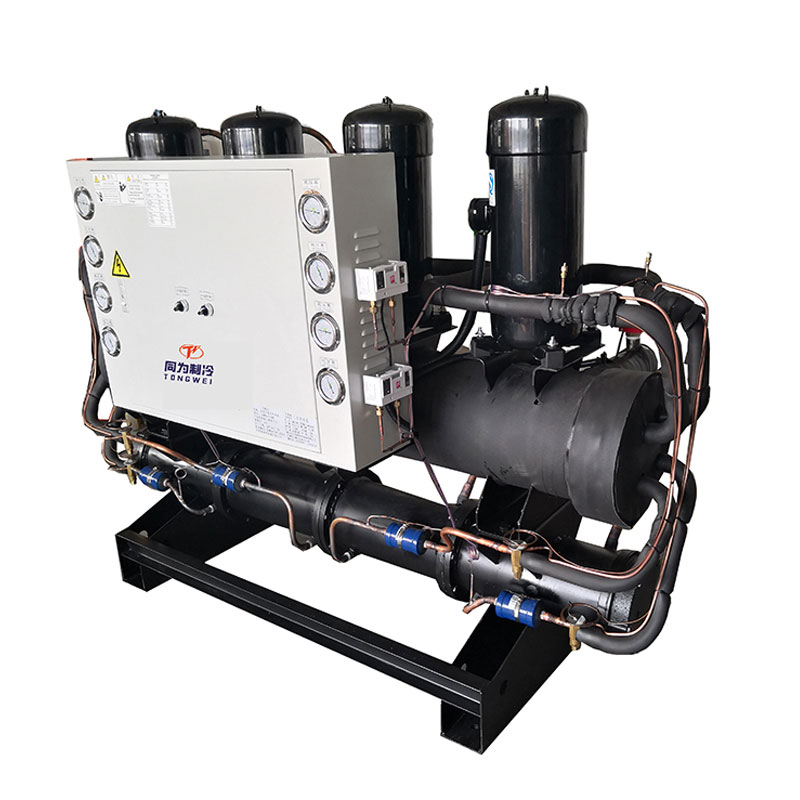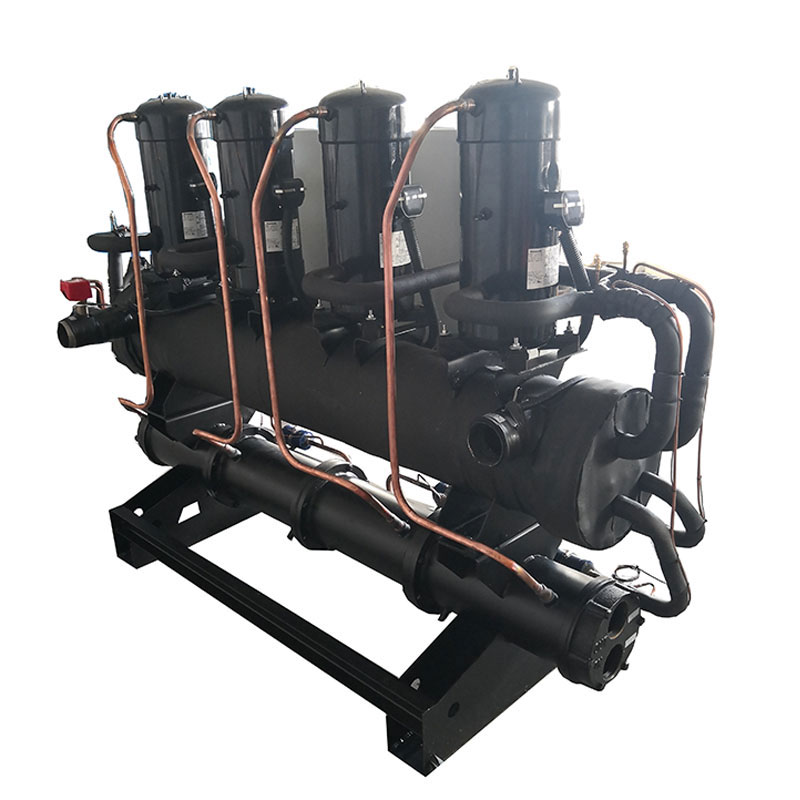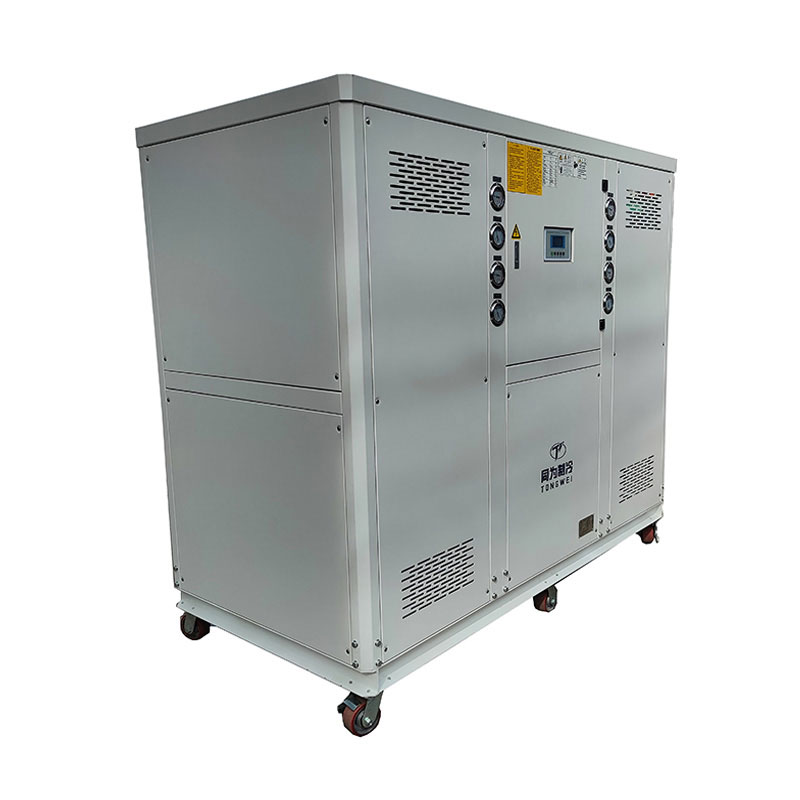Copyright © 2023 Guangdong Tongwei Machinery Co., Ltd. All Rights Reserved.
Links | Sitemap | RSS | XML | Privacy PolicyGlycol Water Chiller For Brewery Industry
Tongwei is professional glycol water chiller manufacturer and supplier providing a full stock of varying variety models from 1/2 ton to 200 tons air-cooled gycol chiller and water-cooled glycol chiller with chiller water temperature from -30℃ to 5 ℃. Glycol water chiller is providing steady glycol coolant that is used in different applications such as:craft beer brewery cold chilling of juice and beer, nano Brewery, wort, brew house chiller, prepackaging brewery distilleries, wineries, cider mills brewery.Our glycol water chiller for brewery industry need install with cooling tower for heat dissipate and all are with 12 months warranty, any problem caused by defects of chiller itself, service offered till the problem within warranty.We look forward to becoming your long-term glycol water chiller system in China Cooling Capacity: 2 Ton to 200 Ton Chilled Water Temperature :-30℃ to 5℃ Refrigerant: Environmental Friendly R404a Power Supply: 380V/50HZ /3PH (Standard) / 208-480V/60HZ/3PH(Customized) Compressor Brand: Panasonic /Danfsoo Scroll Compressor Evaporator Type: SS Plate Type (Standard) / Shell and Tube Customized)
Send Inquiry
Glycol Water Chiller For Brewery Industry
Glycol water chiller is a type of cooling machine that is used to get low temperature regulation in different industrial applications by using glycol and water mixture as a coolant to release heat out of the system.A chiller is a refrigeration system used to cool a barrel of ethylene glycol to lower its temperature. The glycol is then passed through a closed loop of one or more pipes connected to the glycol chiller. This circulates the cooled glycol and helps lower the temperature of anything attached to the system.Glycol water chiller for brewery is also called brewery chiller or brewery cooling system,which used in the fermentation and pull down (cold crashing) process typically circulate about -2℃ glycol for 0℃ beer. Brewery chillers run at temperatures below 32°F (freezing) and thus require propylene glycol.
Glycol water chiller is with specific components like the Panasonic/Danfoss compressor for scroll glycol chiller from 1/2HP to 60HP ,Hnablle/Bizter compresor for screw glycol chiller above 30HP, air-cooled or water-cooled condenser, refrigerant water tank, glycol pump, stainless steel plate or shell and tube heat exchanger, control panel, expansion valves, and protecting devices, etc. For such low temperature glycol chiller ,it uses R404a refrigerant. The refrigerant is a non-depleting ozone gas and is considered environmentally friendly. It need connect with cooling tower and condenser pump for heat dissipate for high cooling efficiency.
As a leading glycol water chiller manufacturer and supplier in China,we design brewery process chiller with one purpose in mind: to keep your brewery-making equipment running strong. With over 15 years of experience, we offer a robust range of industrial grade air cooled and water cooled systems. We design cost-effective and reliable custom solutions to meet your brewery's unique process cooling requirements, bringing our industry-leading engineering and service expertise to ensure reliability and ease of operation. We have a dedicated technical and customer support team who will guide you through the brewery chiller selection and startup process and be there for you long after installation. Rely on our industry-leading expertise to help you maximize your brewery operations and profits.If you are looking for glycol chiller system for your application, please feel free to contact us to customized your glycol cooling water systems with high quality and reasonable price for the low temperature chillers. We look forward to working with you.
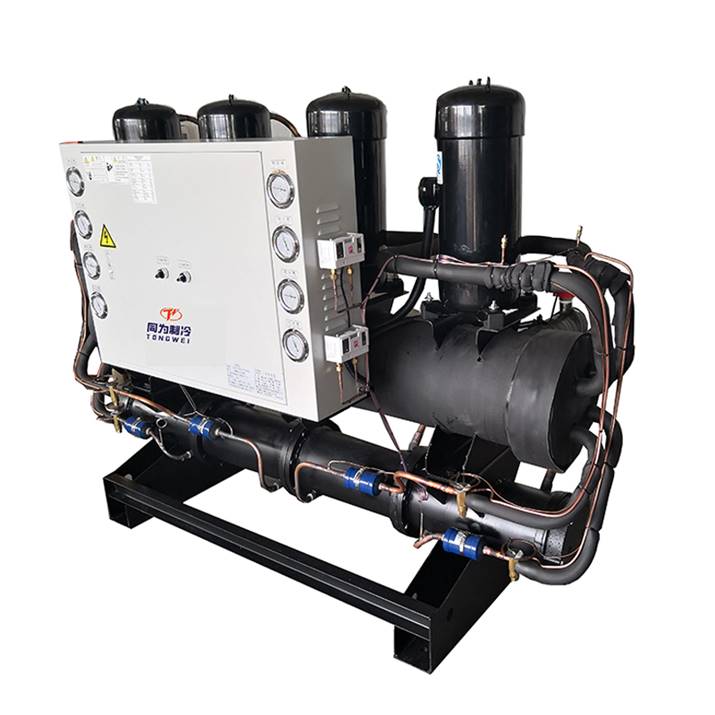
Glycol Water Chiller Technical Specification
| TW-WL Series Glycol Water Chiller Techinical Parameters | |||||||||||||
| Model Item | Temp. | TW-3WL | TW-5WL | TW-6WL | TW-8WL | TW-10WL | TW-12WL | TW-15WL | TW-20WL | TW-25WL | TW-30WL | TW-40WL | |
| Cooling capacity |
KW 50HZ/60HZ |
-10℃ |
4.5 5.4 |
7.7 9.3 |
9.1 11 |
11.7 14.1 |
16.1 19.3 |
19.1 22.9 |
23.3 28 |
32.2 38.6 |
38.2 45.8 |
46.6 56 |
62.5 75 |
| -20℃ |
2.7 3.24 |
4.1 4.92 |
5.3 6.24 |
8.1 9.72 |
9.8 11.76 |
10.6 12.72 |
13.6 16.32 |
20.4 24.48 |
25.00 28.80 |
29.4 35.28 |
38.5 46.2 |
||
| -30℃ |
1.31 1.57 |
2.1 2.52 |
2.8 3.36 |
4.3 5.36 |
4.9 5.88 |
5.6 6.72 |
7.9 9.48 |
11.2 13.44 |
13.7 16.44 |
16.1 19.32 |
21.2 25.44 |
||
| -35℃ |
0.85 1.02 |
1.3 1.56 |
1.9 2.28 |
2.8 3.36 |
3.3 3.96 |
3.8 4.56 |
5.3 6.36 |
7.8 9.36 |
9.4 11.28 |
13.8 16.56 |
17.8 21.36 |
||
| Condenser | Type | Shell and tube | |||||||||||
| cooling water (m3/h) | -10℃ | 1 1.21 | 1.7 2.06 | 2.03 2.44 | 2.62 3.14 | 3.6 4.32 | 4.27 5.12 | 5.2 6.24 | 7.23 8.67 | 8.54 10.25 | 10.4 12.5 | 14 16.8 | |
| -20℃ | 0.61 0.74 | 0.92 1.11 | 1.09 1.31 | 1.82 2.18 | 2.03 2.43 | 2.37 2.84 | 3.04 3.65 | 4.56 5.48 | 5.6 6.71 | 6.58 7.9 | 8.61 10.33 | ||
| -30℃ | 0.31 0.37 | 0.49 0.58 | 0.65 0.78 | 1 1.2 | 1.14 1.36 | 1.3 1.56 | 1.84 2.2 | 2.61 3.13 | 3.19 3.82 | 3.74 4.49 | 4.93 6 | ||
| -35℃ | 0.2 0.24 | 0.31 0.36 | 0.44 0.52 | 0.65 0.78 | 0.77 0.92 | 0.89 1.06 | 1.23 1.48 | 1.81 2.17 | 2.18 2.62 | 3.2 3.84 | 4.13 4.96 | ||
| inlet/outlet pipe | lnch | 1-1/2" | 1-1/2" | 1-1/2" | 1-1/2" | 1-1/2" | 1-1/2" | 2" | 2" | 2-1/2" | 3" | 3" | |
| Evaporator | Type | shell and tube type/Plate type heat exchanger | |||||||||||
| Chilled water (m3/h) | -10℃ | 0.77 0.93 | 1.33 1.59 | 1.56 1.88 | 2.01 1.73 | 2.77 3.32 | 3.28 3.94 | 4 4.8 | 5.56 6.65 | 6.57 7.89 | 8.01 9.62 | 10.75 12.3 | |
| -20℃ | 0.47 0.56 | 0.71 0.85 | 0.91 1.1 | 1.4 1.67 | 1.69 2.02 | 1.82 2.19 | 2.34 2.81 | 3.51 4.21 | 4.3 5.16 | 5.06 6.07 | 6.62 7.94 | ||
| -30℃ | 0.23 0.27 | 0.36 0.44 | 0.48 0.58 | 0.74 0.89 | 0.84 1.01 | 0.96 1.16 | 1.36 1.63 | 1.93 2.31 | 2.36 2.83 | 2.77 3.32 | 3.65 4.48 | ||
| -35℃ | 0.15 0.18 | 0.22 0.27 | 0.33 0.39 | 0.48 0.58 | 0.57 0.68 | 0.65 0.78 | 0.92 1.1 | 1.34 1.61 | 1.62 1.94 | 2.37 2.85 | 3.06 3.67 | ||
| inlet/outlet pipe | lnch | 1" | 1" | 1" | 1" | 1-1/2" | 1-1/2" | 2" | 2" | 2-1/2" | 2-1/2" | 3" | |
| Input power | KW | 3 | 4.5 | 5.25 | 6.75 | 8.6 | 10.1 | 12.8 | 4.56 | 21 | 26.5 | 34 | |
| Max Current | A | 7.5 | 11 | 13 | 16.5 | 21 | 25 | 31 | 42 | 51 | 64 | 83 | |
| power source | 3PH~380V/415V~50HZ/60HZ(3PH~200V/220V 50HZ/60HZ) | ||||||||||||
| Refrigerant | Type | R22(R404A/R507) | |||||||||||
| Control | External balance thermal expansion valve | ||||||||||||
| Compressor | Type | Hermetic scroll ( piston ) | |||||||||||
| Power | KW | 2.25 | 3.75 | 4.5 | 6 | 7.5 | 9 | 11.3 | 7.5*2 | 9.4*2 | 11.3*2 | 30 | |
| Water pump | Power | (KW) | 0.75 | 0.75 | 0.75 | 0.75 | 1.1 | 1.1 | 1.5 | 2.2 | 2.2 | 4 | 4 |
| Max lift | m | 18 | 18 | 18 | 18 | 20 | 20 | 20 | 20 | 20 | 25 | 20 | |
| Safety devices | Compressor overheating protection,overcurrent protection,high and low pressure protection,overtemperature protection,traffic protection,phase sequence/phase loss protection,low level protection,anti-freezing protection. | ||||||||||||
| Dimension | Length | mm | 910 | 910 | 910 | 1250 | 1250 | 1250 | 1600 | 1600 | 1950 | 1950 | 2000 |
| Width | mm | 480 | 480 | 480 | 680 | 680 | 680 | 750 | 750 | 850 | 850 | 980 | |
| Height | mm | 1000 | 1000 | 1000 | 1380 | 1380 | 1380 | 1600 | 1600 | 1700 | 1700 | 1700 | |
| Net weight | Kg | 130 | 150 | 180 | 230 | 260 | 330 | 420 | 460 | 680 | 720 | 870 | |
|
Notes: 1.Rated cooling capacity is based on: chilled water inlet and outlet water temperature 12 ℃ / 7 ℃, the cooling water inlet and outlet temperature 25 ℃ / 30 ℃ 2.Scope of work: chilled water temperature range: 5 ℃ to 35 ℃; chilled water inlet and outlet temperature difference: 3 ℃ to 8 ℃. Cooling water temperature range: 18 ℃ to 37 ℃; cooling water inlet and outlet temperature difference: 3.5 ℃ to 10 ℃. |
|||||||||||||
Features And Advantages of Glycol Water Chiller
▪ Cooling capacity from 1/2 ton to 50 tons for glycol scroll chiller system ,from 30 ton to 100 ton for screw glycol chiller system.
▪ Temperature selection range: Process chilled water between -30°C and 5°C can be provided (users can choose different unit specifications according to different production needs).
▪ High quality Brazed plate/shell and tube as heat exchanger
▪ Inlet and outlet water bypass valves are equipped to adjust the water pressure as needed
▪ The water tank sight glass allows the water level and water quality to be checked at a glance.
▪ Panasonic/Danfoss scroll compressor with environmental friendly R404a refrigerant
▪ It need connect with cooling tower and cooling pump
▪ Chiller equipped with the following safety protections:Overload Protection,Inverse Phase Alarm,High/Low Pressure Alarm,Water Flow,Water Level Indicator,Anti-Freeze Protection
What Are The Main Components Of Glycol Water Chiller For Brewery Industry ?
3.1 Compressor
The compressor is the key mover in glycol water chiller system because it produces pressure variations to stir the refrigerant around.
For Glycol Water Chiller For Brewery, which is with Panasonic /Danfoss brand compressor, using R404a refrigerant,this brand compress is with high refrigeration efficiency,low noise ,energy saving,environmental protection and durability,safety and stability.
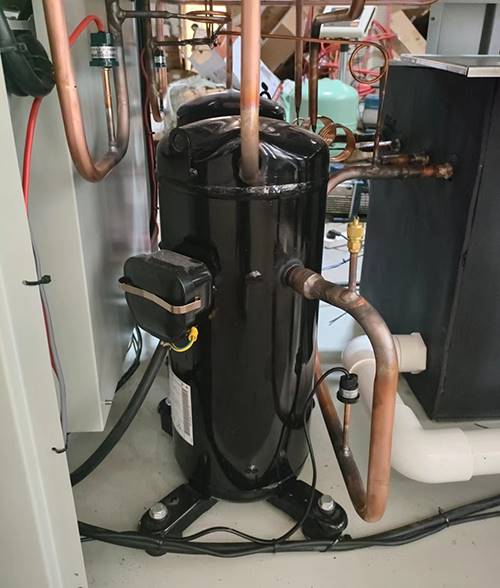
Panasonic Compressor
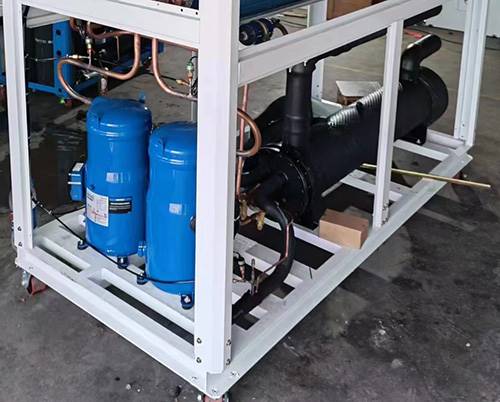
Danfoss Compressor
3.2 Evaporator
The evaporator is a crucial component of glycol water chiller, as it is responsible for extracting heat from the liquid being cooled,it is located between the compressor and the expansion valve. There are three types of evaporators : shell and tube evaporator, 304SS stainless steel plate type evaporator.
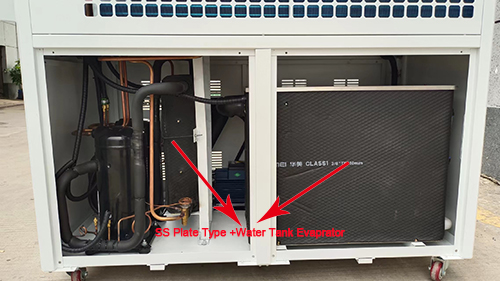
SS Plate Type+ Water Tank Evaporator
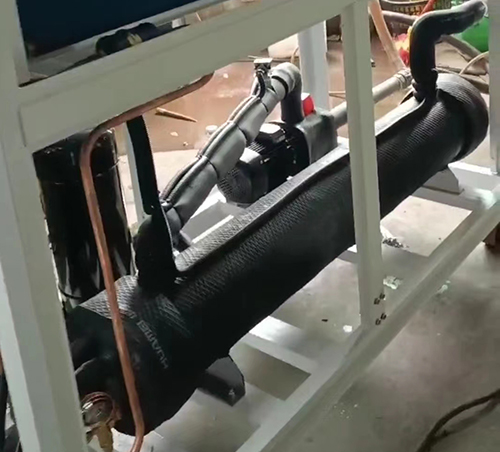
Shell and Tube Evaporator
3.3 Water Pump
The water pump is designed to increase the pressure and the flow of the chilled water in a closed space.
the water pressure water pump for chiller is about 2 bar , but if you need more higher water pressure , pls tell us when you inquiry .For example ,when you use chillers for cooling bottle blowing machine ,the water pressure for water pump need about 4 bar .

Water Pump
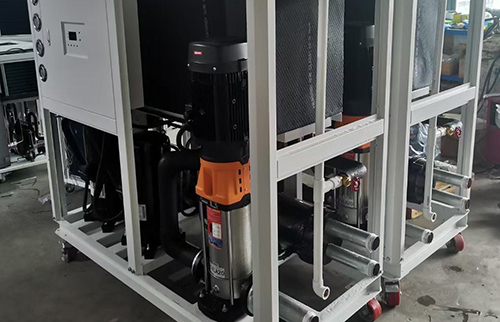
High Pressure Water Pump
3.4 Condenser
The condenser for glycol water chiller is shell and tube ,with the internal copper tubes employing an outer thread embossing process.This design effectively enhances the heat exchange efficiency between the refrigerant and water during the process. Compared to traditional smooth copper tubes, the outer thread embossing process increases the surface area of the copper tubes, thereby expanding the contact area for heat exchange and improving the thermal conductivity of the condenser. This optimization design allows the condenser of the water-cooled glycol chiller to transfer heat from the refrigerant to the water more rapidly and consistently, enabling the water to carry away the heat.
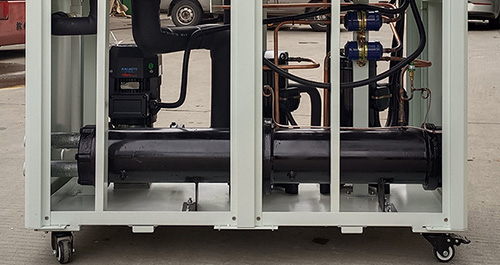
Shell and tube Condenser
3.5 Controller Panel
Tongwei chillers use precision digital temperature controller, it RS485 communication port,which can do remote monitoring and control. Simple operation, low failure rate, high safety factor, easy installation.
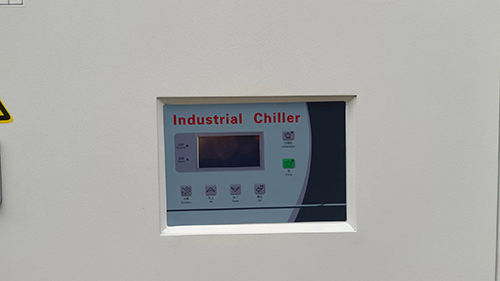
Controller Panel
Spare Part for Glycol Water Chiller
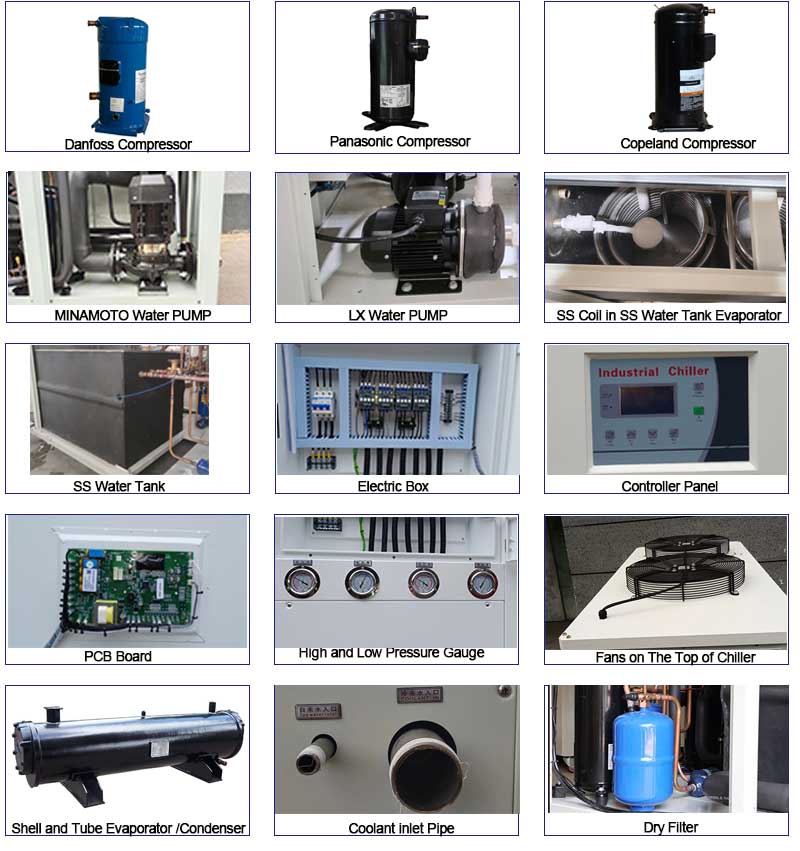
What is the Difference Between Glycol Scroll Brewery Chiller and Glycol Screw Brewery Chiller?
There are two types of glycol brewery chiller: one is air-cooled glycol brewery chiller ,the other is water-cooled glycol brewery chiller ;
Air-cooled glycol brewery chillers use ambient air to dissipate heat from the brewery processes. They are energy-efficient, space-saving, and less maintenance that helps save money.
Water-cooled glycol brewery chillers use water from an external water cooling tower to dissipate heat from the brewery processes. These systems are longer lifespan, Relatively quiet, and more consistent cooling performance than the air-cooled brewery chiller.
Glycol Scroll Brewery Chiller Glycol Screw Brewery Chiller
▪ 1hp-60HP Above 60HP
▪ Danfoss/Panasonic Scroll Compressor Hanbell/Bitzer Screw compressor
▪ Built with water tank and water pump Without water tank and water pump
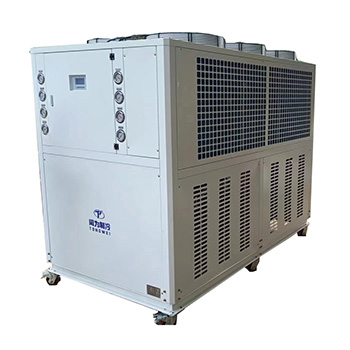
Air Cooled Glycol Scroll Brewery Chiller
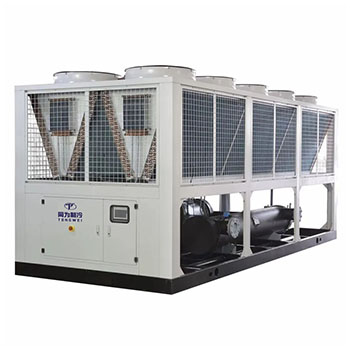
Air Cooled Glycol Screw Brewery Chiller
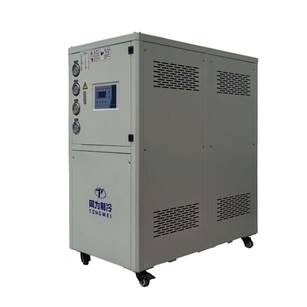
Water Cooled Glycol Scroll Brewery Chiller
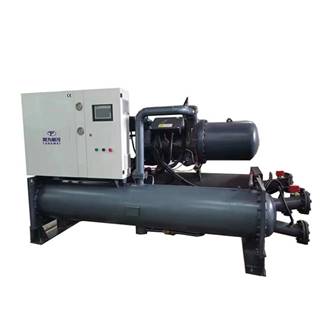
Water Cooled Glycol Screw Brewery Chiller
Why Glycol Is Used for Cooling?
The most commonly used coolant in a chiller is water or a mixture of water-glycol. Glycol-based coolants consist of either ethylene glycol or propylene glycol. The main advantage of glycol coolants is their anti-freeze properties. Pure water freezes at 0 degrees C, while 30% ethylene glycol freezes at -14 degrees C. The low freezing point of glycol mixtures makes them ideal for cooling items that are below the freezing point of water. Although glycol has a lower heat capacity than water (each kilogram of glycol is easier to heat than one kilogram of water), the high temperature difference allows the glycol mixture to dissipate heat more quickly than pure water. The glycol mixtures are more suitable for applications where the chiller must quickly dissipate a large number of heat. In addition to providing excellent heat transfer parameters, glycol tends to discourage algae growth in heat transfer equipment.
Comparison of Ethylene Glycol and Propylene GlycolProperty
|
Property |
Ethylene Glycol |
Propylene Glycol |
|
Freeze point depression |
More effective |
Less effective |
|
Heat transfer efficiency/capacity |
Better |
Less |
|
Viscosity |
Lower |
Higher |
|
Flammability |
Low |
Low |
|
Chemical Oxygen Demand |
Low |
Higher |
|
Biodegrading |
Degradesin 10-30 days |
Needs more than 20-30 days to degrade |
|
Carcinogenic |
No |
No |
|
Toxic |
High level of acute when taken orally, targets the kidneys |
Lower level of acute |
|
Skin Irritant |
Low |
Low |

Ethylene Gycol And Propylene Glycol
How Does Glycol Water Chiller Work?
A glycol chiller is composed of a refrigeration component and tubing containing a water-glycol mixture as coolant. Chilled fluid from the refrigeration unit is channeled through the piping associated with a thermal exchanger surrounding a heated process. After absorbing heat from the associated process, the hot coolant is returned to the refrigeration unit for cooling after which the process is repeated.
A glycol chiller consists of a compressor, an evaporator, a condenser, a throttling element, and an electric control system. Let’s see what’s the working principle of a glycol chiller:
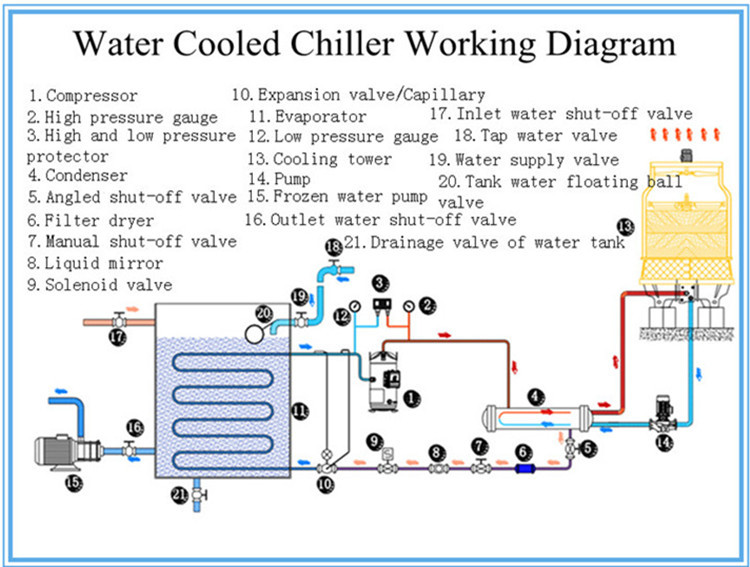
Glycol Chiller Working Principle
The Ratio of Water to Glycol to Use
It is important to use the proper ratio of glycol to water mixture in the cooling system depends on the coldest temperature you need during operation, as insufficient glycol can cause the system to freeze, possibly bursting pipes and even destroying the chiller evaporator even may damage the glycol chiller, while too much glycol to a chiller system will result in an inefficient system.
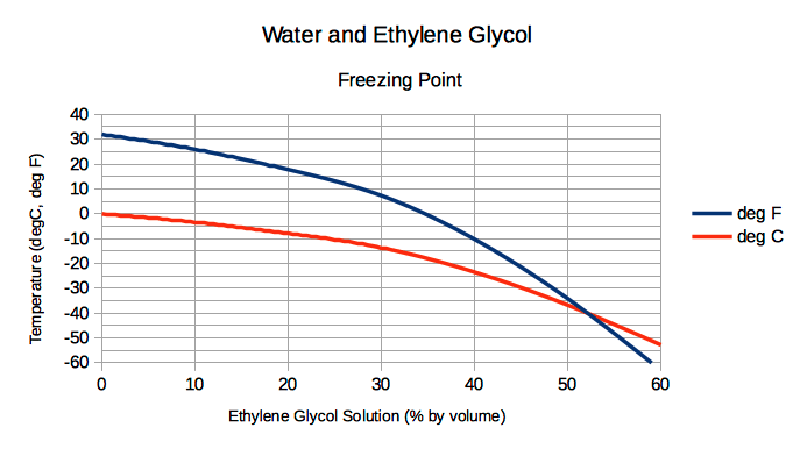
But what’s the best ratio for glycol and water mixtures? Please see below glycol ratio of glycol and water mixtures for the glycol chiller in your cooling process:
|
Glycol |
Water |
Water Temperature |
|
16% |
84% |
0℃ |
|
24% |
76% |
-5℃ |
|
32% |
68% |
-10℃ |
|
40% |
60% |
-15℃ |
|
45% |
55% |
-20℃ |
|
50% |
50% |
-25℃ |
|
55% |
45% |
-30℃ |
How I Can Choose The Right Glycol Water Chiller For Your Application?
There are SIX important chiller specifications you need consider when you choose a chiller for your application :the cooling capacity for chiller ,the voltage required for operation, the associated pump horsepower and flow rate (contact us for custom selection), refrigerant, and the evaporator type.
9.1 Air-Cooled Glycol Chiller or Water-Cooled Glycol Chiller
There are two types of glycol chiller: one is air-cooled type, the other one is water-cooled type.
Air Cooled glycol scroll chillers use aluminum fin+fan as condensers that is similar to the “radiators” in a car.They use a fan to force air through the refrigerant coil. Unless they are specifically designed for high ambient conditions, air-cooled condensers need to operate effectively at an ambient temperature of 45℃ or less.
Water Cooled glycol scroll chiller use shell and tube as condensers.The heat enters the condenser water from the refrigerant vapor. The warm condenser water is then pumped to the water cooling tower, where the heat from the process is eventually vented to the atmosphere.
9.2 Calculate Right Cooling Capacity For Chiller
One of the most frequently ask about how we can know the cooling capacity for chillers. We use KW ,Ton, But/h,Kcal/h to choose chiller cooling capacity :1 KW=860 kcal/h ; 1 TON=3.517 KW;1 KW=3412 Btu/h;
There is also a formula to calculate the cooling capacity for chiller:.
Cooling Capacity(kw)= Flow Rate(m3/h)*Temp Change(T1-T2)/0.86
Heat Load= C(specific heat)* M(quality output per hour )*Temp Change(T1-T2)
Oversize the chiller by 20% Ideal Size in KW = KW x 1.2
Noted : T1:Incoming Water Temperature (℃) T2:Required Chilled Water Temperature(℃)
For example, what size of chiller is required to cool 10m³ water from 35°c to 15 °c in 1 hour?
Temperature Differential = 35℃-15℃=20℃
Water Flow Rate = 10 m³/hour
Cooling Capacity in KW = 10 x 20 ÷ 0.86 = 232 KW
Oversize the chiller = 232 x 1.2 = 278.4KW
278.4 kw cooling capacity for chiller is required.
9.3 Power
Different countries and regions have different standards for industrial electricity, the common power supplies are 208-230V, 380-420V,440-480V,50Hz or 60Hz, 3phase.
Such in Philippines ,the power supply is 220V 60HZ 3PH , 380V 60HZ 3PH ,460V 60HZ 3PH;
in Singapore and Malaysia ,the power supply is 415V 50HZ 3PH;
in Mexico ,the power supply is 220V 60HZ 3PH;
In USA ,the power supply is 208V 60HZ 3PH;575V 60HZ 3PH;480V 60HZ 3PH and so on
9.4 Water Pump
When you decide the capacity/tonnage of the chiller, we will recommend you the suitable pump in KW,which standard water pump is about 2 bar .If you need more high water pressure , please us when you inquiry.
9.5 Refrigerant
R22, R410A, R407C, R404A, R134A are optional choices.
R22: good cooling effect, but R22 is considered a powerful greenhouse gas, so it’s forbidden in most countries.
R410A: eco-friendly, R-410A has replaced R-22 as the preferred refrigerant for use in residential and commercial air conditioners in Japan, Europe, and the United States. R-410A operates at higher pressures than other refrigerants.
R407C: a good replacement for R22, good cooling effect.
R404A: suitable for application that requires low temperature(below -10°c).
R134A: a non-flammable gas used primarily as a “high-temperature” refrigerant, suitable for air-cooled chiller working at a high ambient temperature above 50℃.
9.6 Evaporator Choose
Chillers generally have two types of evaporators: one is stainless steel+ water tank evaporator ,the other one is shell and tube evaporator.
Stainless steel plate and tank evaporator, which has a built-in water storage tank for more convenient use,so there’s no need for extra buffer tanks. This is also our standard evaporator for chiller , if you don’t have buffer tank ,we just use this evaporator for your chiller.
Shell and tube type evaporator, which requires an additional water buffer tank to connect .
Shipping Way of Glycol Water Chiller For Brewery Industry
As a professional low temperature glycol chiller supplier &exporter,we have our own shipment forwarder to arrange the shipment .Our chiller machine is with plywood packing,which prevent damage during transportation and meet export standards.There are three ways can delivery your chiller unit :
1. Ship by Air: As the chiller is with compressor ,water pump and fans ,the compressed refrigerant and oil inside the compressor is a dangerous item with the possibility of explosion , so it needs to release the compressed refrigerant before transportation. (It means that water chiller without refrigerant when choosing this shipping way. After the machine arrives at your destination, you need to add refrigerant by local professionals. The airline company also request us to provide many documents to prove that the chiller not a dangerous product. The freight cost by air is very high may be higher than the cost of chiller , So By air for delivery is not the mode of transport recommended to our customer.
2. Ship by Sea: The transportation time is longer than by air , but the freight cost is cheap ,and there is no need to add refrigerant after the equipment arrives at the destination.This shipping way is the most suitable mode of transportation for you to delivery your local port.
3.If you have your own shipment container in your other supplier in China, we can help you delivery the chiller machine to your supplier in any city of China .
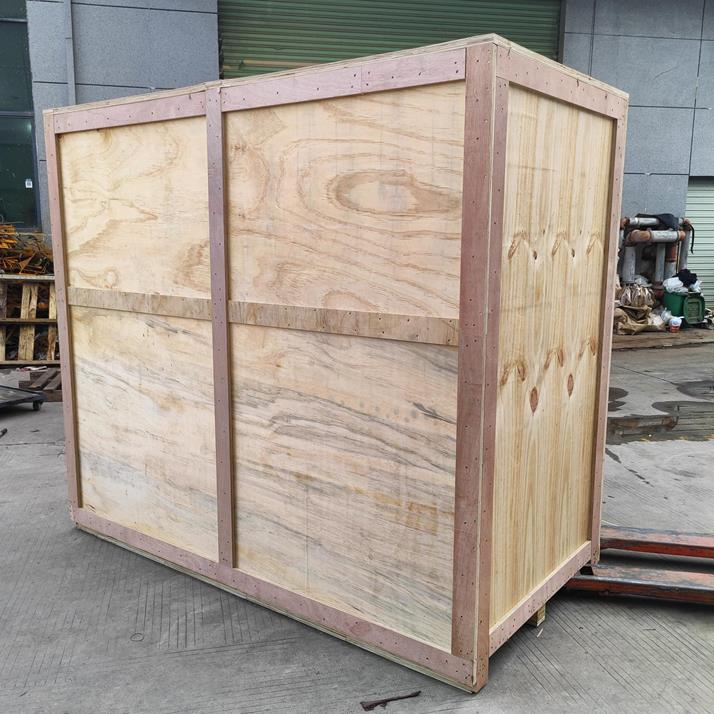
Why should you choose Tongwei for your glycol chiller system supplier?
▪ Experience you can trust
We have been designing and building water chiller for over 15 years. From air cooled chiller to water cooled chillers and everything in between, we have built chillers for nearly every industry and every application.
▪ Fast Quote
Get a quote for your project today! We typically provide a custom quote within 2 hours.
▪ 24/7 customer service
Believe that we will always be by your side. Whether you have a question or need a quote, there‘s always someone answering the phone 24 hours a day.
▪ Durable and reliable machine
Our products are manufactured from high quality materials and we offer a competitive warranty on all industrial chillers.



